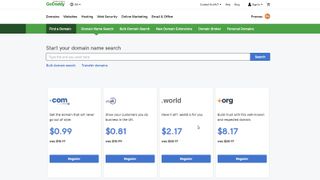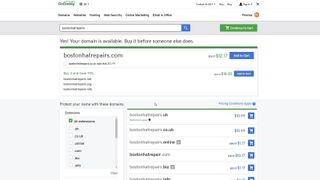How to choose a domain name for your website
Domain names are something of a first impression on the web. Because the domain is often the very first thing that any browsing customer encounters, it needs to send the right message, and an appropriately professional vibe.
Therefore getting it right from the outset is very important – indeed it’s possibly one of the most critical choices to make when it comes to implementing your website. The right domain is all about being found easily and repeatedly by those who want to visit, and achieving this isn’t as simple as it might sound.
Furthermore, a bonus of having a domain is that you can quote a domain email address – something that looks distinctly more professional than one which points to a Yahoo or Gmail account.
Here is a list of considerations to keep in mind when selecting a domain name.
1. Keep it short
The more letters you ask people to type in, the greater the chance that they’ll make some kind of an error, type the wrong thing in, and therefore fail to find you. A length of six letters is ideal, and you certainly want less than eight characters. While we’re at it, definitely avoid ‘supercalifragilisticexpialidocious.com’, as someone has already registered that.

2. Be in the right domain extension
When the internet first began there were relatively few choices of extensions (the final letters of the URL). Most businesses used .com while a few opted for .org as an alternative.
These days every country has a two or three letter code, and the number of subject variations is significant.
These are the most common ones:
- .co – Often an abbreviation for company, commerce or community
- .info – Informational sites
- .net – Typically these are internet infrastructure sites
- .org – Non-commercial organizations and non-profits
- .biz – Business or commercial use, for those that don’t like .com
- .me – Blogs or other personal sites
And often you can find these combined with geographic extensions, as in .co.uk (a company in the UK).
For big businesses, it is practical to take all the major subdomains for their chosen name, and redirect them to either the same site or regionalized versions.
Whatever you choose, bear in mind that picking the right extension could be the difference between being found or not.
If in doubt go with .com because it is still considered to be the best choice for commercial entities with a global market presence, and it sends a message that you are a professional operation.
3. Check existing domains
If you come up with a name for your site, the very first thing to do is check if someone else has already registered that domain. GoDaddy has an excellent tool for doing this, which you can find here.
You might also want to check obvious misspellings of that domain and consider registering them to bring those searchers to you.
Having a name that is very similar to another website could end with a legal challenge and confused customers on both sides. So take care to pick something that is unmistakably you, and not Amazen.com or Gooogle.com.
4. Do a language check
A language check might seem an odd thing to do, but a word that seems innocuous in English might have less wonderful connotations in other languages.
Spending heavily on branding only to discover that a website name is unintentionally insulting to people on the other side of the globe isn’t an ideal scenario.
Ford recently encountered this snag when the company launched the Ford Kuga. After the worldwide product launch, they were informed that in the Balkans, ‘Kuga’ is the word for the Black Death, responsible for the demise of up to 200 million Europeans from 1347 to 1351.
There are much worse examples of this type of mistake, so always check.

5. Do trademark searches
Using a word, or even part of a word, that another business has trademarked could be very problematic. This is especially true if the word you’ve come up with is a fabricated one, and therefore isn’t covered under the protections offered by common usage.
A good place to check is knowem.com, as this will show you if a word has been used as a trademark, in a domain, or even if the word has been used on social media sites.
6. Avoid hyphens and numbers
As a rule, avoid hyphens and also underscores because they can easily be confused. And, for the same reason, generally avoid numbers, as a zero and the letter ‘o’ are also difficult to differentiate between.

7. Consider focusing locally
If you don’t have global ambitions and you are just running a hat repair service in Boston, then BostonHatRepair.com is a good choice. Putting the place your business covers in the name will likely bring anyone in the surrounding area to your site when they search for hat repairs.
The only caveat to this plan is that Boston, for example, isn’t only in Massachusetts.
There is the original Boston in Lincolnshire, England, and 15 more of them in the US, a couple in South Africa, Ireland, Uzbekistan, Costa Rica and Columbia, and others in Jamaica, Peru, Italy, Cuba, Bolivia and Andorra. Again, be sure to consider every angle when picking a name.
There is the original Boston in Lincolnshire, England, and 15 more of them in the US, a couple in South Africa, Ireland, Uzbekistan, Costa Rica and Columbia, and others in Jamaica, Peru, Italy, Cuba, Bolivia and Andorra. Again, be sure to consider every angle when picking a name.
8. Memorable is good
Easy to recall websites are much more likely to be found, and they’re also easier to pass on by word of mouth. Bearing the latter in mind, it also helps if the name is easy to pronounce, and depending on if you’re looking at a global audience, whether it’s easy to say in other languages aside from English.
Coming up with something snappy and memorable can be tricky, but finding a name that fits this criteria will have a positive impact on traffic levels.
9. Try a word generator
If you get stuck for ideas, you could always have a dabble with online word generators that take key words and merge them in interesting ways. Try TextFixer.


Comments
Post a Comment